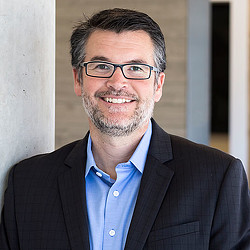Creating Meaningful Content for the Built Environment
September 23, 2020 | By David Kramer
Every day since 1998 thousands of people have lined up to watch a choreographed water fountain show at the Bellagio Hotel in Las Vegas. Why does this attraction continue to be a must-see experience and a backdrop of countless selfies, marriage proposals, and lifelong memories?
To understand the phenomenon, you have to accept the reality that the Bellagio fountains aren’t really fountains at all. They are an elaborate canvas for storytelling. The water, the lights, the music — they weave a narrative with all the hallmarks of a great yarn: suspense, climax, and resolution. The fountains are simply the medium for the story. And the story is what gives the fountains meaning — what imbues them with value and gives them such magnetic power.
For many, storytelling is synonymous with screens. But good content is not limited to cellphones, TVs, or giant monitors in Times Square — stories are omnipresent and can take any shape and size we imagine.
As digital experience designers, we design content for a vast range of spaces including airports, corporate campuses, museums, entertainment venues, healthcare centers, retailers, and more. The storytelling content that helps curate the atmosphere of these places generally includes one or all of these mediums:
Light, in all its forms. From interactive LED fixtures on the side of Shanghai Tower to microscopic pixels of light flickering on our phones, light is one of the primary and most powerful mediums for content. Light can be shaped to create a sense of mood and its intensity can also send signals to cue productivity or relaxation for example.
Kinetic surfaces. New technology allows for materials and surfaces to move and react to physical presence. “Brixels,” for example, are light-reflective bricks that spin around as users pass by.
Sound. Sound has the power to transport listeners to other worlds or make them feel like they’re participating in other activities — think about how the simple clap sound effect can make us feel present and connected as we cheer on professional teams currently playing in empty stadiums. Often operating at a subconscious level, sound provides a soundtrack that powerfully shapes our perception of a space.
There are three overarching concepts that help frame content in the built environment.
Real-time. Real-time content is rendered on-the-fly, using advanced computing to draw imagery in thousandths of a second. Think of motion-sensor displays you might see in a corporate office lobby or museum that reacts to your movement to create new configurations.
Pre-rendered. Pre-rendered content is the opposite of real-time content. It’s been captured or “drawn” and won’t change, no matter how many times it’s played back. The digital billboards in Times Square are a good example of this kind of content.
Generative. Generative content relies on software mediation for its creation. That software could be artificial intelligence or a simple algorithm that converts data to a visual representation. Generative content can be real-time or pre-rendered. Consider digital art made from millions of photos of people’s faces or in the case of one client, a digital display for their plaza created from video clips of a popular TV show.
These days, digital creators are also mixing real-time and pre-rendered content, spawning innovative hybrid forms. For example, the birds in the Cabrini Hospital video, below, might be pre-rendered elements triggered by interactivity, while the exhaust from the rocket ship could be a real-time, generative system.
Sometimes referred to as media architecture, content in the built environment is light, sound, and visuals created for a specific space. It can redefine how we think of a building or space and in some cases, content can become the environment itself. The Atelier des Lumières in Paris is a blacked-out room comprised entirely of giant screens. The content projected onto those screens defines the space (and the sensory-driven experience) for everyone who visits it.
Every building or space contains specific media and platforms, which in turn require a bespoke approach for developing content that is authentic, impactful, and drives the return on investment in architecture. Content in the built environment accomplishes this by:
- Magnifying the client’s brand and messages
- Engaging employees or customers at an emotional level
- Supporting the programming (in the architectural sense of that word) of a built environment
- Differentiating built environments
When multiple digital touchpoints or platforms are at play, it’s possible to weave complex ecosystems of content that reinforce and magnify common themes or messages. In order to do so successfully, it’s important to consider the following elements:
Pacing and Tempo: It’s counter-intuitive, but the content on a computer monitor traveling slowly from one side of your screen to the other can move 100 times faster across a 100-foot wall. When the content surface is scaled up, so is the rate of speed. When designing content for a wall or other large surface, it’s important to slow things down for it to work at an architectural scale.
Details: Attention to detail is key, especially when working with slower speeds. Think about viewing a painting and how your eyes move slowly across the canvas, taking it all in. Content in the built environment needs to offer that same level of richness.
Scale: Traditional content only has to work for an audience at a fixed distance, such as the distance between you and a movie screen (240 inches) or between you and your phone (5 inches). But content in the built environment needs to work for someone 100 feet away as well as someone 3 feet away. Often, we need to draw someone to a screen from a far distance, but then must also deliver a compelling, up-close and personal experience.
Sensory Integration: Whether at an airport, restaurant, or school, we experience our built environments through our senses. If done well, content designed for those spaces can tie together light, motion, scent, and sound into a fully immersive and unique experience.
Existing Conditions: In planning content, the built environment presents plenty of physical challenges for programming. For example, low-contrast content won’t work in a sunlit area and vice-versa. It’s important to be sensitive to the end-user's experience and having multiple audio tracks or one on a continuous loop can be unappealing for some listeners and placing moving content too close to exit signs can be disorienting.
Designing content at an architectural scale comes with a plethora of special considerations and requires a deep understanding of the variety of potential solutions available. But when done right, it is a powerful mode of communication that can leave an indelible impression on all who visit a space, piquing curiosity and engaging visitors at an emotional and intellectual level.
As with the success of the Bellagio fountains, the ultimate goal of creating a content-rich experience within the built environment is to share magical moments that simultaneously affirm the importance of a place while also transcending it. Thoughtfully curated and displayed content in the built environment fires the imagination and confirms our humanity, signaling to everyone who experiences it, “This can only happen here. This can only happen now. And you are a part of it.
For media inquiries, email .

